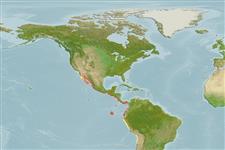分类 / Names
俗名 | 同种异名 | Catalog of Fishes(属, 种) | ITIS | CoL | WoRMS | Cloffa
Teleostei >
Scombriformes (Mackerels) >
Scombridae (Mackerels, tunas, bonitos) > Scombrinae
Etymology: Scomberomorus: Latin, scomber = mackerel + Greek, moros = silly, stupid (Ref. 45335).
More on authors: Jordan & Starks.
Environment: milieu / climate zone / depth range / distribution range
生态学
海洋; 海洋洄游的 (Ref. 51243); 深度上下限 10 - 60 m (Ref. 91172). 熱帶; 33°N - 27°S, 121°W - 70°W (Ref. 168)
Eastern Central Pacific: La Jolla in southern California, USA to the Galapagos Islands and Paita, Peru. Recently reported from Antofagasta, Chile. Many authors have erroneously considered this species to be a synonym of Scomberomorus maculatus, or a subspecies of it.
中太平洋東部: 在美國的南加州到中的 La Jolla 加拉巴哥群島與 Paita ,祕魯。 最近記錄自 Antofagasta ,智利。 許多作家已經錯誤地認為這種是一個 Scomberomorus maculatus 的同種異名 , 或一個它的亞種。
Length at first maturity / 大小 / 重量 / 年龄
Maturity: Lm 43.9, range 26 - 32 cm
Max length : 99.0 cm FL 雄鱼/尚未辨别雌雄; (Ref. 40637); common length : 60.0 cm FL 雄鱼/尚未辨别雌雄; (Ref. 168); 最大体重: 8.2 kg (Ref. 4699)
背棘 (总数) : 15 - 18; 背的软条 (总数) : 16 - 19; 臀鳍软条: 16 - 21; 脊椎骨: 46 - 49. Interpelvic process small and bifid. Body covered with small scales. Lateral line gradually curving down toward caudal peduncle. Intestine with 2 folds and 3 limbs. Swim bladder absent. Pelvic fins relatively long. Sides silvery with numerous round brownish (orange in life) spots, three rows above lateral line, one above. The first dorsal fin is black distally and white at the base. The second dorsal fin is tinged with yellowish and with black margin. The anal fin is white.
腹鳍间的突起小而两裂的。 身体覆盖着小鳞片。 侧线逐渐地对于尾柄弯曲下来。 肠道有 2 摺层与 3 肢翼。 泳鳔不存在。 腹鳍相当长的。 侧边银色的有很多的圆褐色的 (橘色的活着时) 斑点, 三列在侧联机面, 一条在。上面 第一背鳍末梢部地是黑色的与在基底的白色。 第二个背鳍被有些许色调淡黄色的而且有黑色的边缘。 臀鳍是白色的。
A schooling species believed to spawn close to the coast over most of its range. Adults occur near the surface of coastal waters to over bottom of the continental shelf (Ref. 11035). Adults feed on small fishes, particularly anchovies (Anchoa and Cetengraulis) and clupeids (Odontognathus and Opisthonema). The most abundant game fish along the Pacific coasts of Mexico and Central America. An excellent food fish enough to support a commercial fishery. Marketed fresh and frozen; also used for ceviche (Ref. 9987).
相信的一个群游性鱼种产卵接近海岸在大部分的它分布范围之上。 生活于靠近对大陆架的底部上的沿岸水域的表面。 (参考文献 11035) 成鱼吃小鱼, 特别地 鱼 ( Anchoa 与 Cetengraulis) 与鲱鱼 ( Odontognathus 与 Opisthonema). 最丰富的游钓鱼类沿着太平洋的墨西哥海岸与中美洲。 它是优良的食用鱼充足支撑一个商业的渔场。 在市场上销售生鲜和冷冻; 也用来 ceviche 。 (参考文献 9987)
Life cycle and mating behavior
成熟度 | 繁殖 | 产卵场 | 卵 | 孕卵数 | 仔鱼
中太平洋東部: 在美國的南加州到中的 La Jolla 加拉巴哥群島與 Paita ,祕魯。 最近記錄自 Antofagasta ,智利。 許多作家已經錯誤地認為這種是一個 Scomberomorus maculatus 的同種異名 , 或一個它的亞種。
Collette, B.B. and C.E. Nauen, 1983. FAO Species Catalogue. Vol. 2. Scombrids of the world. An annotated and illustrated catalogue of tunas, mackerels, bonitos and related species known to date. Rome: FAO. FAO Fish. Synop. 125(2):137 p. (Ref. 168)
世界自然保护联盟红皮书 (Ref. 130435: Version 2024-2)
人类利用
渔业: 商业性; 游钓鱼种: 是的
工具
特别资料
下载 XML
网络资源
Estimates based on models
Preferred temperature (Ref.
123201): 19.4 - 28.9, mean 25.8 °C (based on 80 cells).
Phylogenetic diversity index (Ref.
82804): PD
50 = 0.5000 [Uniqueness, from 0.5 = low to 2.0 = high].
Bayesian length-weight: a=0.00617 (0.00405 - 0.00940), b=2.93 (2.81 - 3.05), in cm total length, based on LWR estimates for this species & Genus-body shape (Ref.
93245).
营养阶层 (Ref.
69278): 4.5 ±0.8 se; based on diet studies.
回复力 (Ref.
120179): 中等的, 族群倍增时间最少 1.4 - 4.4年 (Assuming tm=2-4).
Prior r = 0.57, 95% CL = 0.37 - 0.85, Based on 1 data-limited stock assessment.
Fishing Vulnerability (Ref.
59153): Moderate to high vulnerability (51 of 100).
Climate Vulnerability (Ref.
125649): High vulnerability (64 of 100).
Nutrients (Ref.
124155): Calcium = 32.7 [14.5, 115.5] mg/100g; Iron = 0.827 [0.363, 2.008] mg/100g; Protein = 20.7 [19.4, 21.9] %; Omega3 = 0.253 [0.153, 0.419] g/100g; Selenium = 54.2 [19.9, 174.5] μg/100g; VitaminA = 23.4 [5.6, 102.0] μg/100g; Zinc = 0.651 [0.429, 1.035] mg/100g (wet weight);
